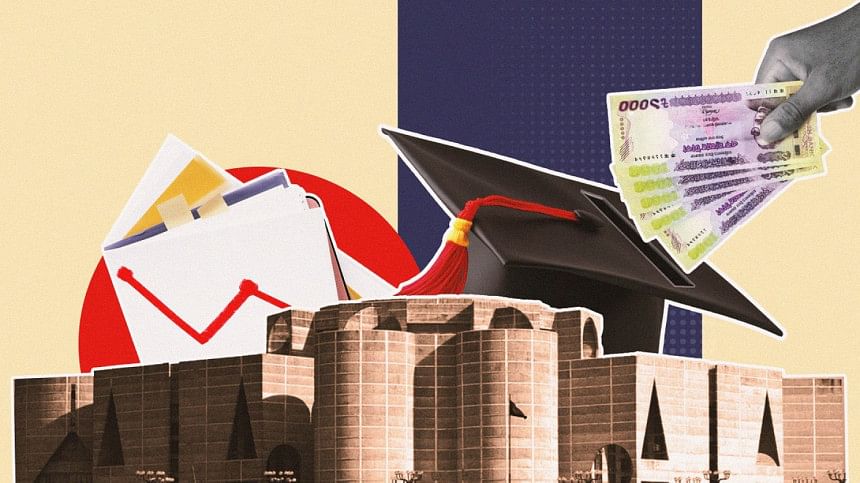Budget for Education: What’s the real impact on students?

Every year the government announces how they plan to allocate funds and which areas to focus their expenditure. Education is among the top priorities. This year (Fiscal year 2024-25) the proposed allocation for the education sector is BDT 94,710 crore, an increase from last year's revised budget of BDT 88,162 crore.
So has the budget for education really increased? In nominal terms, yes, but when we look at the allocation in percentage of GDP we find that it has decreased from 1.76 last year to 1.69 this year. Not only is this the lowest allocation in the last 16 years, but it is even more concerning as it falls way below UNESCO's recommended 4 to 6 percent allocation of GDP for this sector.
In regards to this, Professor Sayema Haque Bidisha of the Department of Economics, University of Dhaka, says, "Compared to the South Asian and LMIC average, we invest much less in our education sector. Most of our efforts are centred on infrastructural development such as more classrooms, computer labs, and textbooks. There is hardly any emphasis on increasing the quality of education by, say, better remuneration for primary school teachers. If we cannot incentivise good students to become teachers in primary schools, then the foundation will remain weak."
The lack of well-educated primary school teachers, especially in rural areas, hinders the ability of students to learn and achieve higher levels of qualification. While bigger classrooms and better facilities are useful, teachers are the biggest driving force.
Professor Sharmind Neelormi of the Department of Economics, Jahangirnagar University, echoed similar concerns about the lack of emphasis on quality development and also talked about the gender gap in education.
"If we look at the Gender Budget Index 2023, we can see that Bangladesh is number 1 in the world for primary school education enrollment but for secondary school enrollment the rank drops to 116. There are many reasons for this, child marriage and lack of proper sanitary system being a few. Despite this gender gap, there is no suggestion for improvement regarding this in the gender budget," says Professor Neelormi.
The negligence of quality education is reflected in the growing youth unemployment rates. The Labor Force Survey Report 2022 shows that tertiary education graduates have the highest unemployment rates among all levels of education, 12 percent to be exact. However, according to data reported by Bangladesh Bureau of Statistics (BBS), from the total number of unemployed graduates, female graduates make up around 19 percent. The survey further revealed that the rate of joblessness increased with the level of higher education.
"There is a skill mismatch between what is being taught in academia and what industry demands," says Professor Bidisha. "We need to equip our students in the way the job market requires, be it through specialised diplomas or rigorous training. Most importantly, we need to invest in our education system now more than ever because implementation is slower in this sector and results will only come about in the long run".
When asked about recommendations to increase the youth unemployment rate, especially among women, Professor Neelormi responded. "We see that urban female labour force participation is trailing far behind rural females. This means we have many educated but unemployed females which is not good for the development of our country. The budget should include ways to help them find jobs, such as through job creation, vocational training, and quotas. It's hard for rural women to avail startup capital as banks prefer to give out larger loans and the lengthy paperwork often becomes a big barrier for them" she explained.
While it's a good sign that rural female labour force participation (FLFP) is increasing, it means that more women are working in the agricultural sector where there is low pay and requires low skill levels. To uplift women from low to high-skill jobs, there must be an emphasis on primary education and job creation.
Overall, the budget for education has not increased in real terms. There are many areas which need further attention. The budget needs to prioritise the quality of education over infrastructural developments in schools and colleges. The gender gap should also be kept in mind when making policies. Vocational training, job creation and specialised diplomas were a few suggestions to help decrease the vast number of educated graduates in the country. Most importantly, the budget for education needs to be on par with the global standard. We can only reap the benefits of education in the long run so we must invest today.
Noyolee Munim is 4th year student of the Department of Economics, University of Dhaka.

 For all latest news, follow The Daily Star's Google News channel.
For all latest news, follow The Daily Star's Google News channel. 








Comments